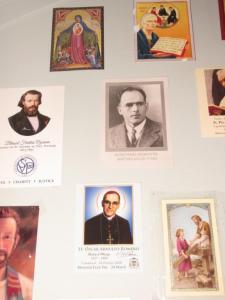 Constantine’s conversion to Christianity was an event of monumental importance; Christians believed that his baptism would be special, reflecting the significance of the event itself. It should come as no surprise that the lackluster historical reality — that Constantine was baptized more or less on his deathbed, at the end of a failed military campaign – did not follow expectations.[1] Eventually orthodox Christians saw his baptism by a heretical bishop to be totally unacceptable. This great man had called the Council of Nicea; he had to be an orthodox Christian. How could he not be? So how can he be baptized by a heretic? Once the circumstances surrounding his death were lost, it was possible for the story of Constantine’s baptism to be changed. As stated before, this was a process which took time, and it certainly was not based upon bad faith. By the time of Theodosius, Constantine had become so equated with both the triumph of Christianity and the triumph of Christian orthodoxy,[2] it was believed that his life must demonstrate both of these truths at once. The triumph of Christianity was the triumph of God’s providence; out of necessity, therefore, God’s power had to be expressed in the narratives about Constantine’s conversion to Christianity. Once the earliest records, such as those written by Eusbeius, were ignored, [3] there was ample room to create a new vision and understanding of his conversion, based often on the imagination of a hagiographical author trying to re-create what they thought his life must really have been like.
Constantine’s conversion to Christianity was an event of monumental importance; Christians believed that his baptism would be special, reflecting the significance of the event itself. It should come as no surprise that the lackluster historical reality — that Constantine was baptized more or less on his deathbed, at the end of a failed military campaign – did not follow expectations.[1] Eventually orthodox Christians saw his baptism by a heretical bishop to be totally unacceptable. This great man had called the Council of Nicea; he had to be an orthodox Christian. How could he not be? So how can he be baptized by a heretic? Once the circumstances surrounding his death were lost, it was possible for the story of Constantine’s baptism to be changed. As stated before, this was a process which took time, and it certainly was not based upon bad faith. By the time of Theodosius, Constantine had become so equated with both the triumph of Christianity and the triumph of Christian orthodoxy,[2] it was believed that his life must demonstrate both of these truths at once. The triumph of Christianity was the triumph of God’s providence; out of necessity, therefore, God’s power had to be expressed in the narratives about Constantine’s conversion to Christianity. Once the earliest records, such as those written by Eusbeius, were ignored, [3] there was ample room to create a new vision and understanding of his conversion, based often on the imagination of a hagiographical author trying to re-create what they thought his life must really have been like.
The story which eventually came about showed the powerful handiwork of God in converting Constantine and expressed the superiority of the Christian faith over his former pagan beliefs. Because it declared what a pious Christian expected, it was easily accepted as the historical account of Constantine’s conversion. When there a reason so as to dispute its authenticity, because it contained contradictions with other legends about Constantine, the Christian scholar tried as best they could to offer a legitimate reason to explain that difficulty away.[4]
In what way did the normative legend come to portray Constantine’s change of faith?[5] Before his conversion, Constantine was shown to be like his predecessors: a persecutor of the Christian faith. Pope Silvester had gone into hiding, fleeing from this persecution. But then Constantine became infected with leprosy, and his doctors could not cure it. The priests of Rome came to him, and they told him that he could be cured if he washed himself in a font filled with the blood of infants. At first he agreed to this, and he had many infants brought to the font, and he was ready to have them slain. Then, as the words put into his mouth show, his “… serenity, perceiving the tears of their mothers, felt an immediate abhorrence of the crime.”[6] Having sent the children back home with gifts, Constantine was rewarded for his act of charity. That evening he was given a vision in his sleep. In it he saw Peter and Paul imploring him to send for Pope Silvester, for the Pope could lead him to end his idolatrous practices, to help him convert to the Christian faith, and finally to be baptized. Not entirely understanding his dream, he obeyed its dictates and had Silvester brought to him. Constantine told the Pope of his dream and asked, “Who were these gods Peter and Paul?”[7] Silvester explained that they were not gods, but followers of Jesus Christ. Constantine, wanting to make sure of his dream, asked if there were any pictures of Peter and Paul that he could see. Silvester had a deacon fetch images of the two Apostles, and Constantine confirmed they were indeed the men from his dream.
Silvester set up a time in which Constantine prepared for his baptism through penance. When Silvester believed Constantine was ready, Constantine made an open proclamation of his new faith and renounced his old pagan beliefs with all of “Satan’s mummery.”[8] Constantine was led to the baptismal font and received the traditional baptism of triple-immersion in the name of the Holy Trinity. Having been cleansed from the evils of his past, he was cured from the leprosy which had afflicted him. Then, as the Edict of Constantine portrays beautifully, Constantine’s gave a full confession of his new faith:
And thus on the first day after I had received the mystery of holy baptism, and after my body had been cured of the blight of leprosy, I apprehended that there was no god by the Father, Son and Holy Spirit, whom blessed Silvester the pope proclaims, the Trinity in unity and unity in Trinity. For all the gods of the nations, whom I have worshiped up to this time, are clearly proved to be daemons, the work of human hands.[9]
There should be no surprise that such a tale would be accepted by Christians: it is easy to believe that God uses influential people like Constantine to demonstrate his power and mercy. Christians came to know Constantine and his conversion as a triumph of Christianity and orthodox Trinitarian dogmatics.
Footnotes
[1] Indeed, Church historians quickly expunged records of Constantine’s Iranian campaign. Because of this, even many of his pagan critics thought Constantine was not sufficiently militaristic. “The Church historians from Rufinus onward all, as we have seen, narrate Constantine’s death without reference to the Iranian campaign, despite their indebtedness to Eusebius in other respects. It may have been partly their fault that the last of the polytheist historians, Zosimus, could accuse Constantine of being utterly unwarlike…” Garth Fowden, “The Last Days of Constantine,” 152.
[2] “…posterity made Constantine a more successful propagator of the Niceaean definition than he had been in reality,” Ibid., 170.
[3] Samuel Lieu, discussing the Byzantine life of Constantine that developed, expresses how Eusebius had come to be ignored and how hagiographers therefore had to rely upon later, legendary material to write upon his life. “In Byzantium, Constantine was not merely a Christian emperor or even the first Christian emperor. He was celebrated as a saint […] The V.C. [life of Constantine note mine] with its cumbersome archive of documents and scanty narrative is hardly an ideal source for the hagiographer […] Moreover, the V.C. did not provide information on a number of important landmarks in the life of Constantine,” Samuel N.C. Lieu and Dominic Montserrat, From Constantine to Julian: Pagan and Byzantine Views (New York: Routledge, 1996), 99-100. “Once the main contemporary source on the life of Constantine was put to one side, the Byzantine hagiographer or menologist had precious little to draw from […],” Ibid., 100.
[4] For example, we can see this attempted reconstruction and clarification of events in The Golden Legend. The question that Jacobus de Voragine raised was simple: if Constantine had been granted a vision of the cross and had gained victory by it, why did he then remain in unbelief and, if the legends are correct, persecute Christians? His answer is interesting. “There are those who hold that it was not Constantine the great emperor who was converted and baptized by Pope Saint Eusebius, as some historians seem to imply, but Constantine’s father, also named Constantine, as we find in some other histories; for the later Constantine came to the faith in a different way, as we read in the legend of Saint Silvester, and he was baptized not by Eusebius but by Silvester,” Jacobus de Vorgaine, The Golden Legend: Readings on the Saints. Vol. 1. Translated by William Granger Ryan. (Princeton: Princeton University Press, 1993), 279.
[5] The events in the following narrative are related in many sources, including the Acts of Silvester, The Edict of Constantine to Pope Silvester, The Golden Legend, and The Anonymous Life of Constantine (BHG 364). Because of the importance of The Edict of Constantine to Pope Silvester (better known as the “Donation of Constantine”), and the format by which it portrayed itself (as an autobiographical story), it shall be used for the textual examples which follow.
[6] The Edict of Constantine to Pope Silvester in Mark Edwards, Constantine and Christendom: The Oration to the Saints. The Greek and Latin Accounts of the Discovery of the Cross. The Edict of Constantine to Pope Silvester (Liverpool: Liverpool University Press, 2003), 100.
[7] Ibid., 102.
[8] Ibid., 103.
[9] Ibid., 104.












